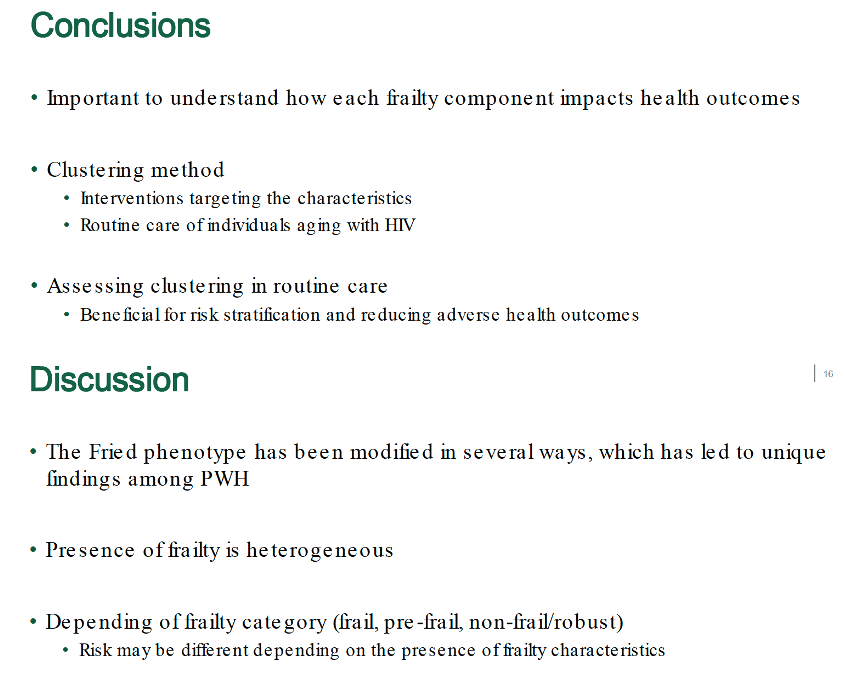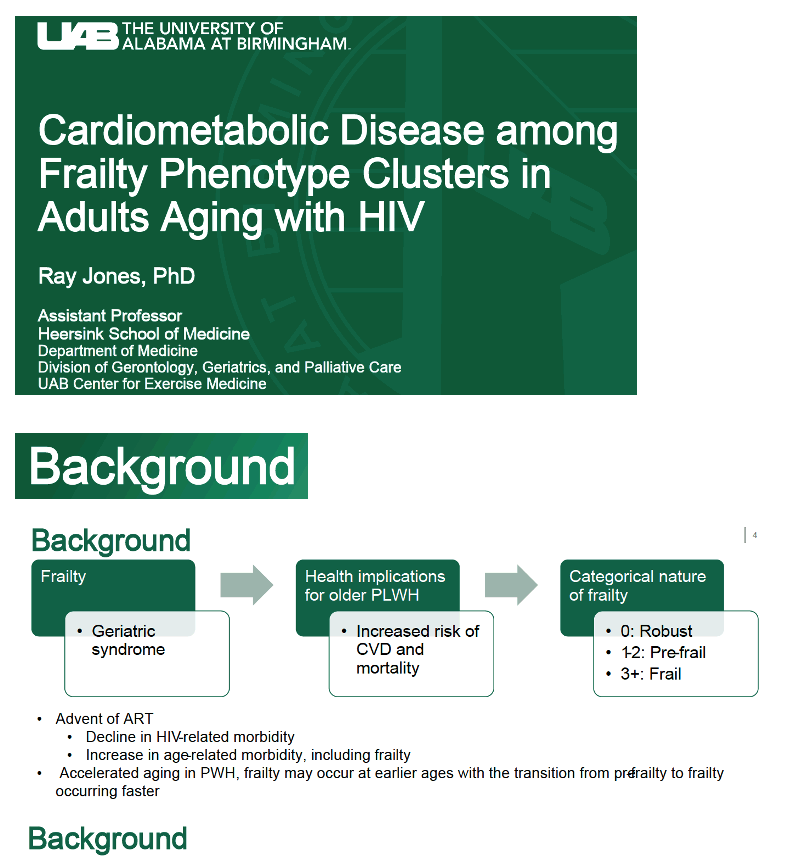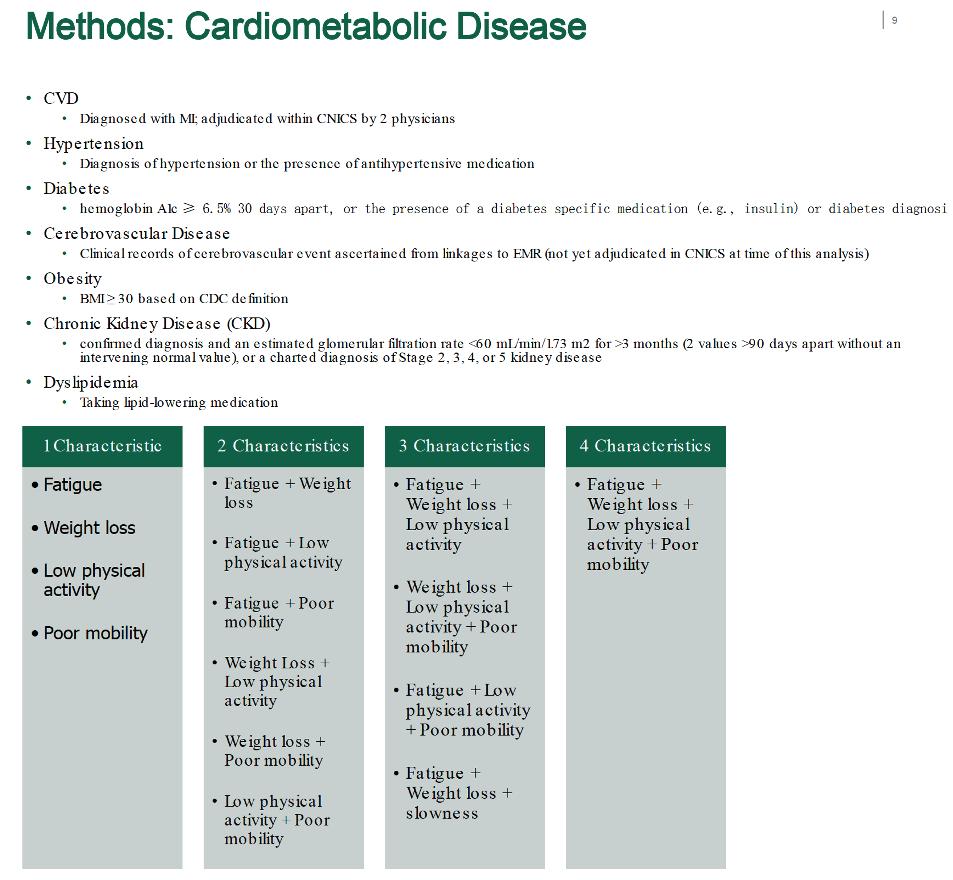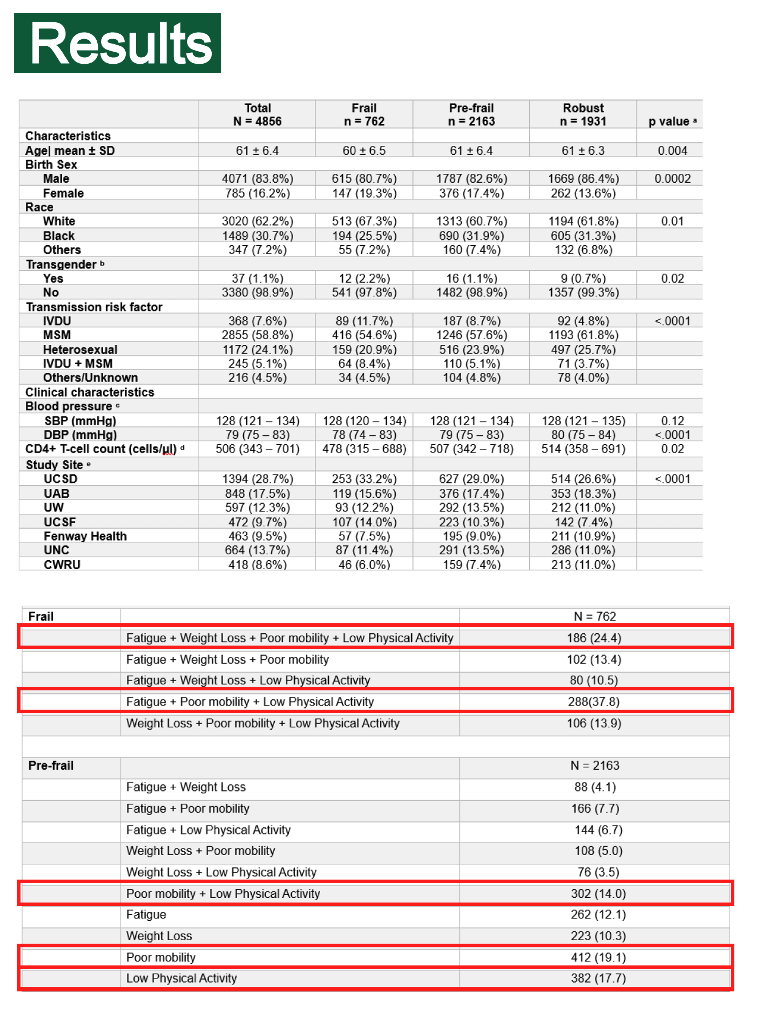 |
 |
 |
| |
Clustering Frailty Components May Enable Sharper Comorbidity Insights
|
| |
| |
International Workshop on HIV & Aging 2023, October 26-27, Washington, DC
Reported by Mark Mascolini for NATAP and Academic Medical Education
Clustering individual components of a modified Fried frailty phenotype into groups of 1, 2, 3, or 4 components underlined the great variety of prefrailty and frailty in people with HIV and showed that different frailty clusters predicted different sets of cardiometabolic diseases [1]. This analysis of 4856 people with HIV found that even solitary components of the frailty phenotype could independently boost odds of a cardiometabolic disease.
Researchers from the University of Alabama and other members of the Center for AIDS Research (CFAR) Network of Integrated Clinical Systems (CNICS) noted that frailty occurs at an earlier age in people with HIV than in the general population because of the combined impact of faster physiologic aging and high incidence of comorbidities. The 5-component Fried frailty phenotype has proved itself useful in studies of people with or without HIV [2].
CNICS investigators wondered how grouping frailty characteristics into clusters of 1, 2, 3, or 4 components would affect associations with cardiometabolic disease, which they defined as cardiovascular disease, hypertension, diabetes, cerebrovascular disease, obesity, chronic kidney disease, and dyslipidemia (abnormal lipids). For this analysis they used 4 frailty phenotype components: unintentional weight loss, low physical activity, fatigue, and poor mobility. They left out the fifth component of the original phenotype, weakness (grip strength) [2]. Absence of any component meant a person was nonfrail, presence of 1 or 2 components meant prefrailty, and presence of 3 or 4 components meant frailty. CNICS statisticians used logistic regression adjusted for age and sex to explore associations between particular component clusters and cardiometabolic disease.
The analysis involved all CNICS participants at least 50 years old who took antiretroviral therapy and had complete clinical assessment data at some point between January 2011 and December 2021. In the 4856 people who met these criteria, median age stood at 61 years, 1489 (30.7%) were black, 785 (16.2%) were women, 2855 (58.8%) were men who have sex with men, and 368 (7.6%) were people who inject drugs. Of these 4856 people, 762 (15.7%) were frail, 2163 (44.5%) were prefrail, and 1931 (39.8%) were nonfrail.
Almost one quarter of the 762 frail people (24.4%) had all 4 frailty components-fatigue, weight loss, poor mobility, and low physical activity. More than one third (37.8%) had fatigue, poor mobility, and low physical activity. Among the 2163 people with prefrailty, 19.1% had poor mobility alone, 17.7% had low physical activity alone, 14.0% had poor mobility and low physical activity, 12.1% had fatigue alone, 7.7% had fatigue and poor mobility, 6.7% had fatigue plus low physical activity, 5.0% had weight loss and poor mobility, 4.1% had fatigue and weight loss, and 3.5% had weight loss and low physical activity.
In multivariate logistic regression, being prefrail versus nonfrail, or frail versus nonfrail, independently boosted odds of almost all 7 cardiometabolic diseases. The one exception to this landslide outcome was that being frail versus nonfrail did not independently change odds of dyslipidemia.

Among 2-component clusters, poor mobility plus low physical activity posed the greatest threat in this study group, independently upping the odds of all 7 cardiometabolic conditions studied. Even being prefrail with only 1 frailty component could independently boost odds of several conditions. For example, poor mobility alone raised the odds of diabetes, chronic kidney disease, hypertension, and obesity, while low physical activity alone hoisted odds of diabetes, hypertension, dyslipidemia, and obesity.

The CNICS investigators proposed that this clustering of frailty components may make sense as part of routine care for people with HIV because it could help clinicians pick interventions that target specific frailty characteristics. Clustering, they concluded, "may enable providers to prioritize comorbidity management to prevent the progression of frailty in older adults with HIV."
link to oral session
https://www.youtube.com/watch?v=i2P7Qt2SjYk
References
1. Jones R, Enogela E, Ruderman S, et al. Cardiometabolic disease among frailty phenotype clusters in adults aging with HIV. International Workshop on HIV & Aging 2023, October 26-27, Washington, DC. Abstract 17.
2. Fried LP, Tangen CM, Walston J, et al. Frailty in older adults: evidence for a phenotype. J Gerontol A Biol Sci Med Sci. 2001;56:M146-M156. doi: 10.1093/gerona/56.3.m1m46.
https://academic.oup.com/biomedgerontology/article/56/3/M146/545770






|
| |
|
 |
 |
|
|